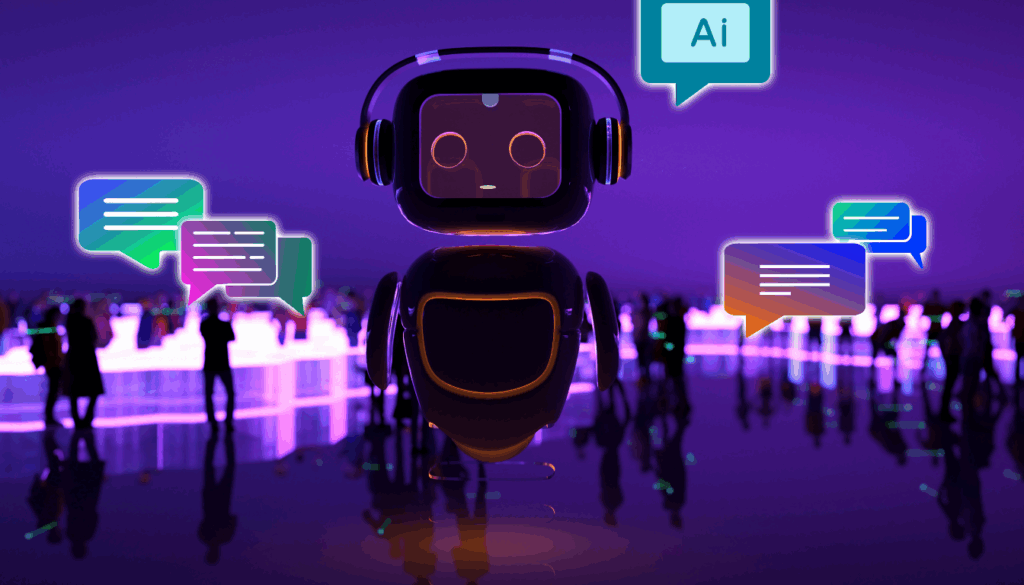Why Every Local Business Needs an AI Chatbot in 2025

Why Every Local Business Needs an AI Chatbot in 2025 Still running your local business like it’s 2020? Hate to break it to you, but 72% of your customers now expect instant answers—even at 3 AM when you’re fast asleep. Let me guess: you’re thinking AI chatbots are just for the big players with deep pockets. I used to think that too. Dead wrong. This guide will show you exactly how small business AI chatbots are revolutionizing customer service without requiring a tech degree or Silicon Valley budget. The reality? Local businesses using AI chatbots are seeing 40% higher customer satisfaction and saving 30+ hours weekly on repetitive questions. All while their competition is still playing phone tag with potential customers. But here’s what nobody’s talking about yet: the surprising way these chatbots are actually generating revenue, not just saving costs… The AI Revolution in Customer Service How AI Chatbots Transform Business-Customer Interactions The days of keeping customers waiting are over. AI chatbots now handle everything from appointment scheduling to product recommendations instantly, creating conversations that feel surprisingly human. Your local coffee shop can answer “Do you have oat milk?” at 2 AM while the owner sleeps. 2025 Market Expectations for AI-Powered Services By 2025, customers won’t just appreciate AI service—they’ll expect it. The businesses thriving then will be those who jumped on board early. Think about it: would you rather call during business hours or get immediate answers anytime? That gap between AI-equipped and traditional businesses is widening every day. Cost-Effective 24/7 Customer Support Breaking Down the Financial Benefits Traditional customer service costs can eat up your budget fast. With an AI chatbot, you’re looking at a one-time setup fee and minimal maintenance costs. Most local businesses see ROI within months, not years, as chatbots handle hundreds of inquiries simultaneously without overtime pay or benefits. Handling Customer Inquiries Without Additional Staff Your small team is already stretched thin. A chatbot takes the pressure off by answering common questions about hours, prices, and availability without human intervention. This frees up your staff to focus on complex issues and in-person interactions that truly need the human touch. Personalization at Scale How AI Creates Tailored Customer Experiences Gone are the days of one-size-fits-all customer service. AI chatbots now analyze purchase history, browsing behavior, and past interactions to create genuinely personalized experiences for every customer who walks through your door (virtually or physically). Data-Driven Customer Insights Your chatbot isn’t just talking—it’s listening. With every conversation, AI gathers valuable data about what your customers actually want. This treasure trove of insights helps you stock the right products, adjust your services, and speak directly to customer needs before they even mention them. Competitive Advantages for Local Businesses A. Closing the Technology Gap with Larger Competitors Small businesses no longer need massive IT departments to compete digitally. Today’s AI chatbots level the playing field with plug-and-play solutions that give mom-and-pop shops the same 24/7 customer service capabilities as retail giants—at a fraction of the cost. B. Neighborhood Presence with Enterprise-Level Service Your local advantage is knowing customers by name. Now pair that with AI that remembers every interaction, preference, and purchase history. This combination creates an unbeatable service experience that big corporations spend millions trying to replicate. Implementation Strategies for Local Business Owners Starting Small: Entry-Level AI Chatbot Solutions Gone are the days when chatbots were just for tech giants. Today’s small business owner can get started with plug-and-play solutions that cost less than your monthly coffee budget. Many platforms offer free trials or basic packages under $100/month, letting you test the waters before diving deeper. Integration with Existing Business Systems The best AI chatbots play nice with what you already have. Whether it’s your appointment booking software, inventory system, or CRM, modern chatbots connect with minimal fuss. Most vendors now offer pre-built integrations with popular tools like Shopify, Square, and Google Calendar—no coding required. The AI chatbot revolution is no longer reserved for large corporations. Local businesses stand to gain tremendous benefits from implementing this technology, from providing round-the-clock customer support without increasing staffing costs to delivering personalized experiences that once required extensive human resources. By adopting AI chatbots, local businesses can level the playing field against larger competitors while maintaining the personal touch that makes them special in their communities. As we move toward 2025, the businesses that thrive will be those that embrace these powerful tools while thoughtfully integrating them into their existing operations. Whether you’re a neighborhood café, local retail shop, or community service provider, now is the time to explore AI chatbot solutions tailored to your specific needs. Your customers are increasingly expecting immediate, personalized service—and with today’s accessible AI technology, you can exceed those expectations while focusing on what you do best: serving your local community. Return to Nutraffix AI
AI Chatbots vs Human Agents: Who Wins in Customer Service?

AI Chatbots vs Human Agents: Who Wins in Customer Service? Ever been trapped in that endless chatbot loop where you just need a human, but all you get are preprogrammed responses that miss your point entirely? Yeah, me too. But here’s the twist – some AI chatbots now solve problems faster than humans do. The AI vs human debate in customer service isn’t just theoretical anymore. It’s happening at every touchpoint where customers interact with brands. In this deep-dive, you’ll discover exactly when AI chatbots outshine their human counterparts and when they fall embarrassingly short. We’ll analyze real case studies showing measurable differences in resolution times, customer satisfaction scores, and bottom-line impact. But before you pick a side in the AI chatbot revolution, there’s something about emotional intelligence that might surprise you… Delivering on the promise of AI in customer experience The Reality Check on AI Customer Service AI promises the world in customer service – magical chatbots that solve problems instantly, never get tired, and cost a fraction of human teams. But here’s the truth: many businesses implement AI solutions only to watch them fail spectacularly. Why? Because they treat AI as a simple plug-and-play solution rather than a carefully crafted component of their customer experience strategy. Bridging the Expectation Gap Most AI implementations fall short because companies: Rush deployment without proper training Don’t integrate AI with existing systems Fail to define clear handoff points to human agents Neglect ongoing optimization The secret to success isn’t choosing between humans OR AI – it’s creating a system where humans AND AI each handle what they do best. Building a Hybrid Customer Service Model The most effective approach combines AI efficiency with human empathy: AI Handles Humans Handle Basic FAQs Complex issues Account lookups Emotional situations Simple transactions Strategic decisions 24/7 availability Building relationships Smart companies are creating AI systems that know their limitations and seamlessly transfer to human agents before customer frustration builds. Measuring What Matters Stop measuring AI success by how many human agents you’ve replaced. Focus instead on: Customer satisfaction scores First-contact resolution rates Overall resolution time Customer retention improvements The winning strategy isn’t about choosing a side in the AI vs. human debate – it’s about creating a thoughtful system where each plays to their strengths. The upsides and downsides AI Chatbots AI chatbots bring serious firepower to customer service operations. They’re always on—24/7 availability means customers get answers at 3 AM just as easily as 3 PM. No waiting, no hold music, just instant responses. Cost savings? Massive. One chatbot can handle thousands of conversations simultaneously, slashing operational expenses by up to 30%. That’s money companies can reinvest elsewhere. But there’s a flip side. Chatbots struggle with nuance and complex issues. They might nail routine questions about return policies or account balances, but throw them a curveball and things get messy fast. Many customers still report frustration when chatbots misinterpret their questions or get stuck in loops. And let’s not forget the personality factor—AI can simulate empathy, but it can’t truly feel it. Human Agents Humans excel where chatbots falter—handling complicated problems that require judgment calls and emotional intelligence. A skilled agent can hear frustration in a customer’s voice and adapt their approach accordingly. People build relationships. That conversation with Sarah from customer service who went above and beyond? That creates loyalty algorithms can’t match. The downsides? Humans need breaks, training, and competitive salaries. They can only handle one conversation at a time, making them significantly more expensive than their digital counterparts. They’re inconsistent too. One agent might bend a policy while another stands firm. And when call volumes spike, wait times stretch, testing customer patience. The reality? Neither option is perfect alone. Smart companies are finding the sweet spot with hybrid approaches—using AI for speed and scale while keeping humans for complexity and connection. Optimising support efficiency with AI chatbots and visual engagement The Perfect Marriage: AI Efficiency and Human Touch Think about the last time you needed customer support. Did you cringe at the thought of navigating through endless automated menus? Or perhaps you dreaded the long wait times for a human agent? The reality is that neither pure AI nor humans-only approaches win the customer service game. The magic happens in the middle. When companies integrate AI chatbots with visual engagement tools, support efficiency skyrockets. AI handles the repetitive stuff—account queries, tracking orders, basic troubleshooting—freeing humans to tackle the complex problems that require empathy and critical thinking. Real-Time Visual Problem Solving Picture this: a customer struggles to set up their new router. Instead of painfully describing blinking lights over the phone, they share their screen or camera feed. The support agent instantly sees the issue—wrong cable in the wrong port—and guides them to the solution in seconds. This is visual engagement at its finest. When paired with AI: Chatbots handle initial diagnostics Visual tools jump in when needed Resolution times drop dramatically Customer satisfaction soars Measuring the Combined Impact Companies implementing this hybrid approach report: Metric Improvement First contact resolution Up 35% Average handle time Down 40% Customer satisfaction Up 28% Agent productivity Up 45% The key isn’t choosing between AI and humans—it’s using AI to make human support dramatically more effective. AI handles volume, humans handle complexity, and visual tools bridge the gap between them. The digital age has transformed customer service, with AI chatbots and human agents each bringing unique strengths to the table. While AI excels at handling routine inquiries with speed and consistency, human agents provide the emotional intelligence and problem-solving capabilities necessary for complex situations. The most effective approach combines both elements—using AI to handle straightforward questions and routing more nuanced issues to human representatives. As businesses develop their customer
Boost Guest Satisfaction with Voice AI: A Must-Have for Modern Hotels

Boost Guest Satisfaction with Voice AI: A Must-Have for Modern Hotels Ever walked into a hotel room and spent 15 minutes figuring out how to turn on the lights or adjust the thermostat? Your guests have, and they’re tired of it. Voice AI is changing everything about the hotel experience. A simple “Turn off all lights” or “Set room temperature to 72 degrees” is all it takes now. No more fumbling with unfamiliar switches or complicated remote controls. Hotels implementing voice technology are seeing guest satisfaction scores jump by up to 30%. It’s not just convenient—it’s becoming what travelers expect. The best part? Voice AI for hotels doesn’t just impress guests; it reduces call volume to the front desk and creates efficiencies across operations. But here’s what most hoteliers don’t realize about voice technology until it’s too late… Understanding Voice AI Technology in Hospitality Understanding Voice AI Technology in Hospitality A. The Evolution of Guest Service Technology Remember when hotel service meant picking up that clunky room phone? Those days are gone. Voice AI has transformed hotel experiences from tedious phone calls to simple voice commands that handle everything from room service to local recommendations. B. How Voice AI Differs from Traditional Guest Services Traditional services require staff interaction and have limited hours. Voice AI never sleeps. It responds instantly to guest requests, learns preferences over time, and delivers consistent service quality without the human variability that can make or break a hotel stay. Immediate Benefits of Voice AI for Guest Experience A. Frictionless Room Controls and Amenity Requests Gone are the days of fumbling with confusing thermostats or calling the front desk for extra towels. Voice AI lets guests simply speak their needs: “Turn down the temperature” or “Send up more pillows.” This hands-free control transforms the stay experience, making everything feel effortless. B. 24/7 Multilingual Support Without Staffing Constraints Voice AI never sleeps and speaks dozens of languages fluently. International guests can ask questions, make requests, or get recommendations in their native tongue at 3 AM just as easily as at 3 PM. No waiting for a translator or limiting service hours. Voice AI as a Competitive Advantage A. Meeting the Expectations of Tech-Savvy Travelers Today’s guests aren’t just hoping for tech amenities—they’re expecting them. When your competitors are still fumbling with paper maps and landline phones, your voice AI system is answering questions instantly and controlling room features effortlessly. This isn’t just convenience—it’s the modern experience travelers crave. B. Creating Memorable Interactions That Drive Loyalty Voice AI doesn’t just answer questions—it creates moments. Imagine a guest’s surprise when your system remembers their name and preferences from their last stay. These personalized touches transform an ordinary hotel stay into a standout experience that keeps guests coming back and telling friends about your property. Implementation Strategies for Hotels of All Sizes A. Scalable Solutions from Boutique to Chain Properties Voice AI isn’t just for luxury chains anymore. Small boutique hotels can start with basic room service and concierge functions, while larger properties can implement comprehensive systems covering everything from check-in to maintenance requests. The beauty? You pay for only what you need, with the ability to scale up as guest expectations grow. B. Integration with Existing Hotel Management Systems Getting voice AI to play nice with your current tech stack isn’t the headache you might expect. Modern voice systems connect seamlessly with popular PMS, CRM, and housekeeping platforms through open APIs. This means guest requests flow directly to the right department without expensive overhauls or starting from scratch. Measuring ROI and Performance of Voice AI Systems Key Metrics to Track for Voice AI Success Tracking the right numbers makes all the difference with voice AI. Look at response accuracy rates, guest usage frequency, and resolution times. These tell you if guests are actually getting what they need or just getting frustrated. Guest Satisfaction Impact Analysis Nothing beats seeing those satisfaction scores climb after voice AI implementation. Hotels typically see 15-30% jumps in guest happiness scores when voice systems work well. The magic happens when guests feel heard without waiting on hold or walking to the front desk. The hospitality landscape has evolved significantly, with Voice AI technology emerging as a transformative tool for hotels seeking to enhance guest satisfaction. From providing instant responses to guest inquiries to personalizing experiences based on preferences, Voice AI delivers tangible benefits that directly impact guest happiness and operational efficiency. Hotels that have embraced this technology are already witnessing competitive advantages through improved service delivery, multilingual support, and valuable data collection. As you consider implementing Voice AI in your hotel, remember that solutions exist for properties of all sizes and budgets. Starting with targeted applications in high-impact areas allows for gradual expansion as you measure performance metrics and ROI. The question is no longer whether Voice AI belongs in your hotel, but rather how quickly you can integrate this technology to meet the rising expectations of today’s tech-savvy travelers. Take the first step toward modernizing your guest experience—your guests and bottom line will thank you. Return to Nutraffix AI
How Voice AI Is Transforming the Hotel Industry in 2025

Imagine walking into your hotel room and simply saying, “I’d like the curtains closed and the temperature set to 72 degrees” – and watching it happen instantly. What once seemed futuristic is now reality as voice AI revolutionizes the hospitality landscape. According to industry research, a striking 79% of hoteliers view voice-enabled technology as their most promising investment, with 62% considering it truly transformative for their operations.
As consumer expectations evolve, hotels can no longer afford to simply place generic smart speakers in rooms. Today’s AI-powered voice solutions integrate with over 30 hotel technologies, creating seamless experiences that enhance guest satisfaction while simultaneously streamlining operations.
3 Smart AI Ideas for Beginners

3 Smart AI Ideas for Beginners Ever wondered why some people dive into AI projects with confidence while you’re still googling “what is machine learning”? Don’t worry – you’re not alone. Remember when smartphones seemed complicated? AI is at that same tipping point between “tech wizardry” and “everyday tool” right now. The truth is, artificial intelligence for beginners doesn’t require a computer science degree or coding expertise. You just need the right entry points that match your skills and interests. I’ve helped dozens of complete novices launch their first AI projects, and I’ve discovered three surprisingly accessible ways to get started that most tutorials miss completely. The first approach takes just 30 minutes to set up and might completely change how you think about what’s possible… Getting Started with AI Tools for Everyday Tasks Simple AI-powered productivity applications Ever felt like there aren’t enough hours in your day? AI tools can help. Apps like Otter.ai transcribe your meetings in real-time, so you can focus on the conversation instead of frantically taking notes. Then there’s Grammarly, which does way more than catch typos—it helps rewrite clunky sentences and suggests tone adjustments. For task management, try Todoist with its AI-powered Smart Schedule feature. It learns your work patterns and suggests optimal times to complete tasks. And don’t overlook Text Blaze, which lets you create snippets that expand into frequently used text—saving you from typing the same responses over and over. Setting up virtual assistants without coding Setting up Google Assistant or Alexa is actually super simple. Just download the app, follow the setup wizard, and you’re good to go. No coding required! Want to take it up a notch? Try IFTTT (If This Then That). It connects different services with simple “if-then” statements. For example: “If I add an event to Google Calendar, then add a reminder in Alexa.” The interface is drag-and-drop easy. For more customization, check out Zapier. It links over 3,000 apps with no-code “Zaps.” Create workflows like automatically saving email attachments to Google Drive or posting social media updates across multiple platforms simultaneously. Free AI resources for beginners Good news—you don’t need to empty your wallet to start with AI. Google Colab offers free access to Python notebooks with GPU support. Perfect for experimenting with machine learning models without expensive hardware. Kaggle provides free datasets, competitions, and tutorials that make learning AI practical and fun. For chatbots, try Botpress’s community edition. It has a visual flow builder that makes creating conversational AI straightforward. And don’t miss out on Fast.ai’s free courses. They flip traditional teaching by starting with practical applications before diving into theory. Measuring your productivity improvements Track your progress to see if these AI tools are actually helping. Start with a time audit—record how long tasks take before implementing AI solutions, then compare afterward. Most AI productivity apps have built-in analytics. Grammarly shows how many errors it caught and how your writing improves over time. Todoist tracks completed tasks and productivity trends. Try the Pomodoro technique alongside your AI tools, using apps like Forest or Focus Booster to measure focused work sessions. Remember—the goal isn’t just working faster, but working smarter. Sometimes the biggest productivity win comes from eliminating unnecessary tasks altogether, which many AI tools excel at identifying. Building Your First AI Chatbot No-code platforms for chatbot creation Building a chatbot used to require serious coding skills. Not anymore! Today’s no-code platforms make it ridiculously easy to create your first AI chatbot. ManyChat and Chatfuel are perfect if you’re targeting Facebook users. They offer drag-and-drop interfaces where you can build conversation flows in minutes. Dialogflow (by Google) gives you more flexibility and can connect to multiple platforms. And if you want something super simple, try Landbot or Tars for website chatbots. Here’s a quick comparison: Platform Best for Learning curve ManyChat Facebook, Instagram Very low Chatfuel Facebook Messenger Low Dialogflow Multi-platform Medium Landbot Websites Very low Tars Lead generation Low Pick one platform and stick with it until you’ve got something working. You can always get fancier later. Designing effective conversation flows The magic of a good chatbot isn’t in fancy AI—it’s in thoughtful conversation design. Start by mapping out the main questions your users will ask. For each question, create a simple response path. Don’t try to handle everything at once. A good conversation flow should: Start with a friendly greeting Offer clear options (buttons work better than free text) Keep responses short and conversational Include escape hatches when users get stuck Your first flow might look something like: Welcome message 2-3 main options (buttons) Specific responses for each option A way to start over or talk to a human Remember: real humans don’t speak in paragraphs. Your chatbot shouldn’t either. Training your chatbot with basic knowledge Think of training your chatbot like teaching a super-literal intern. You need to be specific about everything. Start with a knowledge base of FAQs. What are the 20 most common questions users ask? Write clear, concise answers for each one. For no-code platforms, this usually means creating “intents” (what the user wants) and “entities” (specific information they mention). For example: Intent: Check order statusEntities: Order number, email Then add variations of how people might ask about these topics. “Where’s my order?” “Check my order status” and “Is my package shipped?” should all trigger the same response. Don’t obsess over perfect AI understanding. Start simple and expand as you learn what real users actually ask. Implementing your chatbot on social media or websites Got your chatbot built? Time to set it loose! For websites, most platforms give you either a code snippet or a chat widget to embed. Just copy-paste it into your site’s HTML or use their WordPress plugin. For Facebook Messenger,
5 Ways AI Automation Can Save Time and Money for Small Businesses

5 Ways AI Automation Can Save Time and Money for Small Businesses Are you drowning in administrative tasks while your competition races ahead? Small business owners spend countless hours on repetitive work that could be automated. In fact, AI automation can save an astonishing 109 billion hours monthly of employee time and reduce operational costs by up to 30%! For small businesses operating on tight margins, this represents not just a competitive advantage, but a survival necessity. The good news? You don’t need an enterprise budget to harness the power of AI. Today’s automation tools are more accessible than ever, with low-code solutions enabling even non-technical business owners to implement powerful systems. From streamlining customer service with AI chatbots to automating payroll processing and optimizing your marketing campaigns, these technologies allow you to focus on what truly matters—growing your business and delighting your customers. Let’s explore five powerful ways AI automation can transform your small business operations while saving you precious time and money. Enhancing Customer Service While Reducing Costs Implementing AI chatbots for instant customer support and inquiry management AI chatbots are game-changers for small businesses struggling with customer service demands. They handle basic questions 24/7, slash response times, and cost a fraction of what you’d pay for round-the-clock staffing. Many small business owners report 30-40% reductions in customer service expenses after implementation. Analyzing customer behavior patterns to improve service quality Your customer data is gold waiting to be mined. AI tools can spot buying patterns, identify friction points, and highlight upselling opportunities you might miss. They transform raw customer interactions into actionable insights, helping you deliver personalized experiences that keep customers coming back. Automating Administrative Tasks for Immediate Time Savings A. Streamlining payroll processing with AI tools like Gusto and ADP The payroll headache is real for small business owners. Hours spent calculating taxes, processing payments, and fixing errors could be invested in growing your business instead. AI-powered platforms like Gusto and ADP automatically calculate taxes, process direct deposits, and even handle compliance issues without breaking a sweat. B. Simplifying appointment scheduling and calendar management with Calendly Ever played the endless email ping-pong just to schedule one meeting? Calendly eliminates this time-sink by allowing clients to book appointments based on your actual availability. The AI works silently in the background, sending reminders, handling time zone differences, and integrating with your existing calendar apps. Reducing Operational Costs Through AI-Driven Efficiency Minimizing human error in routine processes Ever noticed how those repetitive tasks are where mistakes happen most? AI automation catches those slip-ups before they become costly problems. Small businesses using AI for data entry and invoicing report up to 90% fewer errors—meaning happier customers and less time fixing mistakes. Decreasing operational expenses by up to 30% The numbers don’t lie. Small businesses implementing AI automation typically slash operational costs by 25-30%. A local accounting firm automated client onboarding and cut processing time from 3 hours to 20 minutes. That’s not just saving money—it’s freeing up your team to do work that actually matters. Optimizing Marketing and Sales Processes A. Scheduling and automating social media posts with Buffer and Hootsuite Small businesses waste too much time on social media. Tools like Buffer and Hootsuite let you schedule posts across platforms in one sitting. Set up a week’s worth of content in an hour, then get back to what matters – running your business. B. Streamlining email marketing campaigns with MailChimp Ever spent all day designing email campaigns? MailChimp’s AI tools create personalized emails based on customer data and automate sending at optimal times. This means higher open rates and more sales without the constant manual work that drains your resources. Creating a Composable Business Structure for Future Growth Integrating disparate data sources for better decision-making Small businesses often struggle with scattered data across different platforms. By connecting your CRM, accounting software, and social media analytics, you get a 360-degree view of operations. This integration isn’t just convenient—it transforms how quickly you can spot trends and opportunities. Building unified customer profiles for personalized experiences Know your customers better than they know themselves. When you merge purchase history, support interactions, and browsing behavior into unified profiles, you can deliver exactly what customers want before they even ask. This predictive approach turns casual buyers into loyal fans who feel genuinely understood. AI automation represents a pivotal opportunity for small businesses looking to thrive in today’s competitive landscape. By implementing AI-powered solutions for customer service, administrative tasks, operational processes, marketing, and sales, small business owners can redirect valuable time toward strategic growth while achieving cost reductions of up to 30%. The integration of tools like chatbots, automated scheduling systems, and CRM platforms eliminates repetitive tasks that once consumed countless hours, allowing teams to focus on creative problem-solving and meaningful customer interactions. As you build your business for the future, consider adopting a composable approach that integrates various AI tools to create a flexible, scalable foundation. The 109 billion hours saved monthly through automation across businesses worldwide demonstrates this isn’t just a passing trend—it’s a fundamental shift in how successful small businesses operate. Start by identifying one area where automation could make an immediate impact in your business, implement a solution, and watch as the time and cost savings compound, positioning your small business for sustainable growth and enhanced customer experiences. Return to Nutraffix AI
3 Profitable AI Business Ideas You Can Start This Year

3 Profitable AI Business Ideas You Can Start This Year In a world where AI is no longer just buzzword but big business, the opportunity to capitalize on this technology has never been more promising. The global AI market is projected to surge from $241.80 billion in 2023 to a staggering $738.80 billion by 2030 – that’s a 17.30% compound annual growth rate! With 90% of businesses already exploring AI platforms and 80% planning to increase their investments, entrepreneurs who act now are positioning themselves at the forefront of a digital gold rush. 💰 Are you looking to ride this wave of innovation but unsure where to begin? You’re not alone. Many aspiring entrepreneurs recognize AI’s potential but struggle to identify viable business models that balance profitability with practicality. The good news? You don’t need to be a technical genius or have millions in startup capital. In this article, we’ll explore three lucrative AI business opportunities that combine low barriers to entry with high-growth potential: AI Automation Agencies that transform business operations, AI Marketing and Content Creation Services that revolutionize digital presence, and Specialized AI SaaS Solutions that solve industry-specific problems. Let’s dive into how you can turn artificial intelligence into very real profits this year. The Booming AI Market: Why Now is the Perfect Time to Start Current market size and projected growth to $738.80 billion by 2030 The artificial intelligence market is experiencing unprecedented growth, making it an ideal time for entrepreneurs to enter this space. In 2023, the global AI market was valued at approximately USD 196.63 billion and is projected to expand at a remarkable compound annual growth rate (CAGR) of 36.6% from 2024 to 2030. Some projections are even more optimistic, suggesting the market could reach up to $1,339 billion by 2030, up from $214 billion in 2024. This explosive growth represents one of the most significant opportunities for business creation in the current decade. Increasing business adoption and investment in AI technologies The rapid adoption of AI technologies across industries demonstrates the growing market demand. Currently, 72% of businesses have integrated AI into at least one operational function, a significant increase from previous years. This widespread adoption isn’t limited to tech giants—97% of business owners believe tools like ChatGPT will benefit their operations, particularly in improving customer relationships and productivity. Investment in AI technologies continues to surge, with major tech companies leading ongoing research and innovation. Despite a slight decline in overall venture capital funding for AI startups recently, investment in generative AI has shown remarkable resilience compared to other technology sectors. This trend is driven by the transformative potential of AI across multiple industries and the rapid user adoption of new AI tools, exemplified by ChatGPT reaching one million users within just five days of its launch. Key areas where AI is creating the most value Several industries are experiencing particularly strong AI-driven transformation, creating lucrative opportunities for new businesses: Healthcare: Projected to witness the highest CAGR among all sectors, with applications in robotic surgery, clinical diagnostics, and data-driven research Advertising and Media: Currently leading the market, with AI’s growing role in marketing strategies and content creation Finance: Utilizing AI for risk management, compliance, and customer service automation Retail: Implementing AI for personalized shopping experiences and supply chain optimization Manufacturing: Employing AI for predictive maintenance and quality control Geographically, North America currently holds the largest market share (43% of total AI funding in 2024), while the Asia-Pacific region is growing rapidly, with India leading global AI adoption at 59%, followed by the UAE and Singapore. Now that we’ve established why the AI market presents such compelling opportunities for entrepreneurs, let’s explore one of the most promising business models in this space: AI Automation Agency. This innovative approach allows entrepreneurs to help businesses transform their operations through strategic AI implementation. AI Automation Agency: Transforming Business Operations Now that we’ve explored why the AI market is booming and ripe for entrepreneurship, let’s dive into one of the most promising AI business ideas: starting an AI automation agency. Helping companies automate repetitive tasks and improve decision-making An AI automation agency focuses on implementing solutions that eliminate mundane, repetitive tasks that drain company resources. Unlike traditional automation, AI-powered systems can learn, adapt, and make decisions, transforming how businesses operate. Many small to mid-sized businesses understand they need AI automation but lack the expertise to implement it. Your agency can bridge this gap by: Identifying processes that don’t require human judgment but consume valuable time Implementing AI tools that enhance decision-making with data-driven insights Creating customized automation workflows that integrate with existing systems Providing ongoing optimization as business needs evolve Targeting small to mid-sized businesses with pilot projects The most effective approach for an AI automation agency is to start with smaller, targeted pilot projects rather than complete business overhauls. This strategy works particularly well because: Small businesses often can’t afford large consulting firms but desperately need automation Pilot projects require lower initial investment from clients, reducing perceived risk Successful small projects build trust and typically lead to expanded engagements Results from pilot projects provide valuable case studies for attracting new clients Consider offering specialized packages for different industries, demonstrating deep understanding of sector-specific needs. Potential revenue streams and implementation strategies An AI automation agency can generate revenue through multiple channels: Implementation fees: One-time charges for setting up automation systems Subscription models: Monthly fees for maintaining and optimizing AI tools Performance-based pricing: Charging based on measurable improvements (cost savings, productivity increases) Training services: Teaching client teams to work alongside AI systems For implementation, follow these proven strategies: Begin with a thorough assessment of client operations to identify highest-impact opportunities Develop clear metrics for measuring success before implementing any solutions Create a phased rollout plan to minimize disruption Provide comprehensive documentation and training for client teams With
AI Chatbots vs. Human Support: Finding the Right Balance for Your Business

Navigating the AI chatbot vs. human support decision? I provide insights to find the right balance for your business’s unique requirements.

